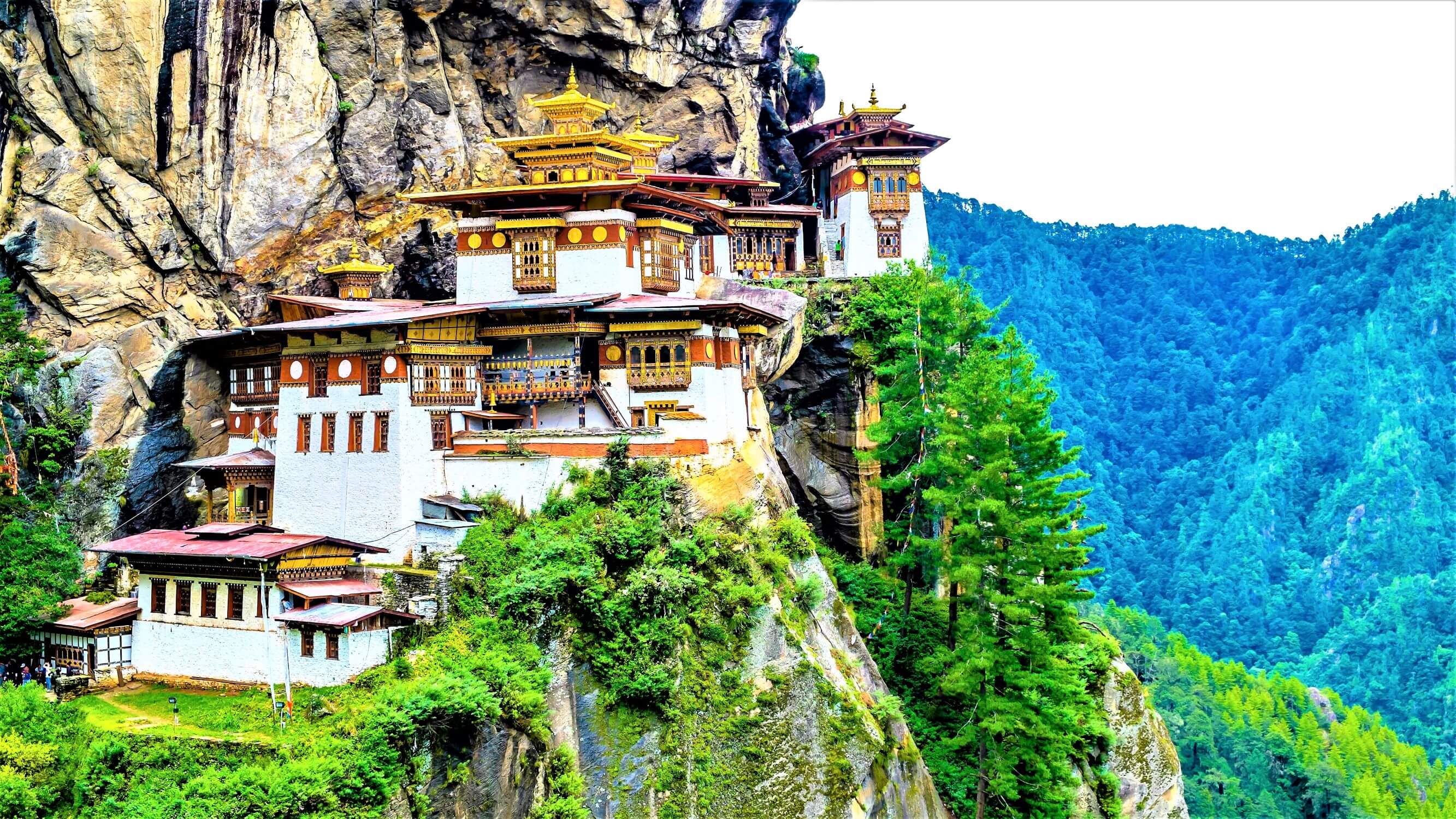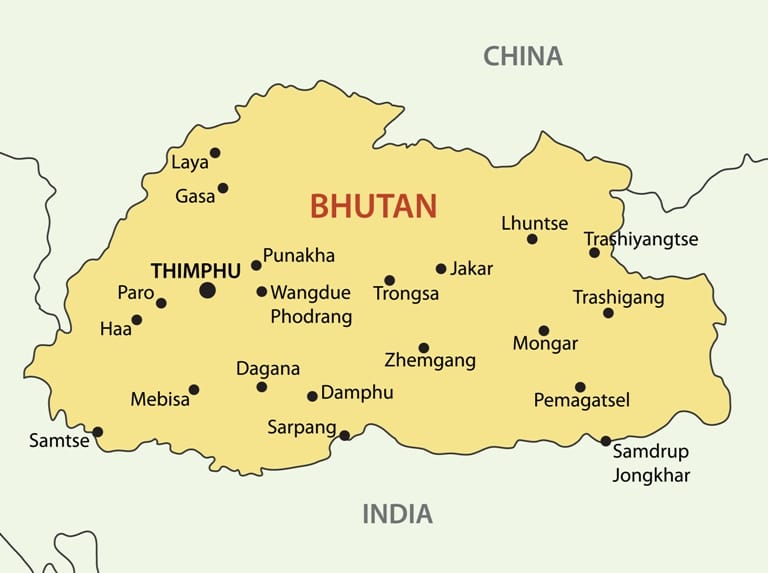


BHUTAN
GENERAL INFORMATION
Bhutan is the only country with Gross National Happiness Index (also known by the acronym: GNH) is a philosophy that guides the government of Bhutan. It includes an index which is used to measure the collective happiness and well-being of a population. A country filled with Dzongs and tales of mystic dragons. The Land of Thunder Dragon, Bhutan is known for its stunning landscapes, legendary ancient temples and fortresses, spicy yet delicious food, colorful festivals and most of all its authenticity. If you wish to slow down your fast-paced city life and relish a moment or two in the lap of Himalayas, Bhutan is the place for you! The charms of this isolated Himalayan Kingdom are knitted strong within its cultural realms. The government takes all measures to preserve its culture, history and rich tradition.
HISTORY AND CLIMATE
Mainland Territory: 47,000 sq km (18,147 sq mi)
Population: 822,700 (2019)
National Capital: Thimpu
International Calling Code: +975
History:
Bhutan was inhabited by people as early as 4,000 years back. There are archaeological evidences indicating settlements in Bhutan dating back to 2,000-1,500 BC. Bhutan in ancient times had many different names; it was known as Druk Yul or the Land of the Thunder Dragon in the 17th century. The outside world however called it Bhutan, derived from a Sanskrit word Bhu-Uttan meaning ‘High Land.’
Bonism was the main religion in Bhutan before the arrival of Buddhism. It was only in the 8thcentury that an Indian saint Guru Padmasambhava, popularly know as Guru Rinpoche brought Buddhism to Bhutan.
Many warlords battling constantly with one another ruled Bhutan until Zhabdrung Ngawang Namgyal from Tibet unified the county in 1616 AD. He established a dual system of governance – the Choe Sid (Spiritual and Religious tradition). After the long period of civil strife that followed the death of Zhabdrung in 1651, power was finally consolidated with the crowning of Gongsar Ugyen Wangchuck as the first hereditary monarch in 1907. The monarchical system continued till 2008 before the Fourth King stepped down and introduced democracy in Bhutan. Today it is a Democratic Constitutional Monarchy.
Best time to travel to Bhutan:
Bhutan has an extremely diverse climate. This is due to the vast variations in altitude, as well as the influence of the southwest and northeast monsoons from India. From late June through September, the southwest monsoon brings heavy rain and high humidity to the southern border region of Bhutan, but the post-monsoon season, from late September through November, there are bright, sunny days and sometimes early snowfall at higher elevations. Winter (November through March) is the northeast monsoon season, which brings gale force winds through high altitude mountain passes, giving Bhutan its name “Drukyul,” meaning Land of the Thunder Dragon.
Winter also sets in, with frost throughout much of the country and snowfall often above 3,000 meters. December and January are the coldest months in Bhutan, with overnight temperatures dropping below zero in Paro, Thimphu, and Bumthang. Spring is generally dry and pleasant, while summer produces occasional showers and maximum temperatures of around 86 degrees Fahrenheit.
Peak Season in Bhutan
Peak season are usually dictated by the months with the most festivals. Many tourists visit Bhutan to experience the country’s fascinating festivals. The Tshechu festivals, held in temples, monasteries, and dzongs (fortresses) all over Bhutan, are a highlight. Communities come together to witness religious mask dances, receive blessings, and socialize at these grand events. Each mask dance has a special meaning behind it, and it’s believed that everyone must attend a Tshechu and see the dances at least once in their lifetime to dissolve their sins.
Spring
Like Autumn, spring in Bhutan is also high tourist season. While the season may be busy, the weather is beautiful and the season hosts many of the country’s best festivals and celebrations. The ideal season for rafting and kayaking in Bhutan is spring, too.
Events to Check Out
- Ura Yakchoe (May): The Ura Valley in Bumthang is renowned for its Ura Yakchoe dance, performed at this festival. During the festival, a sacred and important relic, passed on from generation to generation, is put on display so that people can receive blessings from it.
- Paro Tshechu (April): Held every spring at Rinpung Dzong, this is one of the most colorful and significant events in the Paro district. Early in the morning on the last day of the celebration, the monks display a huge thangka (painting) inside the dzong.
- Punakha Drubehen and Tshechu (March): At picturesque Punakha Dzong, the Punakha Drubchen hosts a dramatic recreation of the scene from Bhutan’s 17th century battle with the Tibetan army, who came to seize a precious relic.
Summer
Bhutan’s monsoon season usually arrives in mid-June, bringing lots of rain. Despite that, the country’s lush greenery and lack of crowds can make it an appealing time to visit.
Events to Check Out
- Kurjey Tshechu (July): The festival takes place at Kurjey Lhakhang, in Bumthang’s Chokhor Valley. Apparently, Guru Rimpoche (who introduced Buddhism to Bhutan) meditated there and left an imprint of his body on a rock inside the temple.
Fall
Fall has mild weather, and like spring, many crowds. The scenery is beautiful, with rice fields turning gold before harvest. Many festivals, including Thimphu Tshechu—one of the country’s biggest, take place during fall.
Events to Check Out
- Thimphu Tshechu (September): This is one of the biggest festivals in Bhutan and people travel from all over the country to see it. It takes place at Tashichho Dzong in Thimphu. Days and nights of prayer and rituals are undertaken to invoke the gods before the festival.
- Jambay Lhakhang Tshechu (November): Jambay Lhakhang, in Bumthang, is one of the oldest temples in the kingdom. The feature of this festival is an unusual fire ritual with naked dance at midnight.
- Wangdue Tshechu (September): This Tshechu is known for the Raksha Mangcham, the Dance of the Ox. It concludes with the unfurling of the great Guru Tshengye Thongdrol thangkha.
- Tamzhing Phala Choetpa (September): Celebrated at Tamzhing Lhakhang in Bumthang, this festival has some rare mask dances unique to the monastery.
Winter
Winter in Bhutan can be quite cold, but visiting during December, before peak winter has set in, can make for a pleasant trip with minimal crowds and lower prices. You can also see the country’s beautiful black-necked cranes in the Phobjikha Valley.
Events to Check Out
- Nomad Festival in Bumthang (February 23, 2017). This unique festival brings together the herders of the northeastern and northwestern Himalayan frontiers in an unforgettable celebration of their culture and traditions.
Ideally: October to December is the ideal time to visit Bhutan as the air is clear and fresh with sunny skies. January and February are colder, but from then until April the climate remains dry and pleasant and in late spring the famous rhododendrons bloom spectacularly, flooding the valleys with color.



